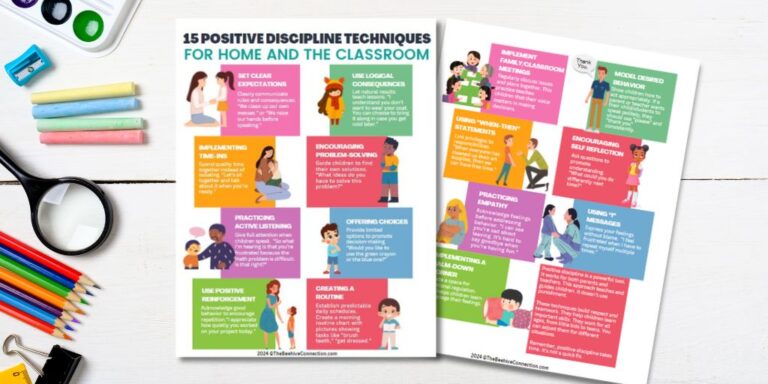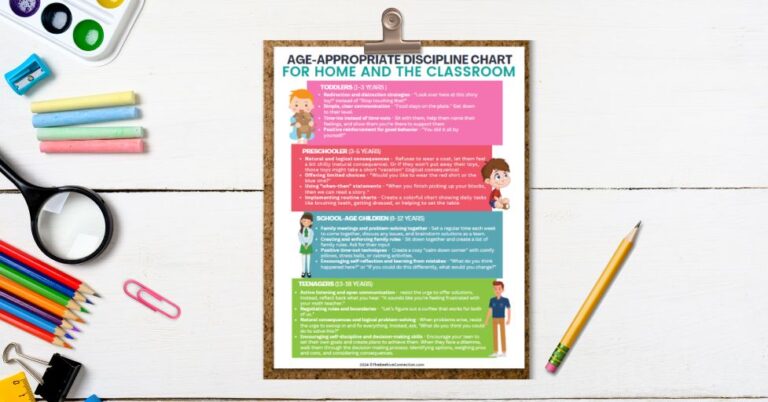10 Best Positive Discipline Books for New Parents for 2025
Disclosure: This post may contain affiliate links, meaning I may get a small commission if you decide to make a purchase through my links, at no cost to you.

Congratulations, new parents! You’re embarking on an incredible journey, but let’s face it – sometimes it feels like you’re navigating uncharted waters. Don’t worry, you’re not alone! As you dive into the world of parenting, you might be wondering, “How can I discipline my child effectively and positively?” Well, I’ve got great news for you!
Check out our Positive Discipline Techniques PDF for Home and the Classroom
There’s a treasure trove of wisdom waiting in the pages of the best positive discipline books for new parents. In this article, we’ll explore the best parenting discipline books that’ll equip you with the tools to raise happy, confident kids while maintaining your sanity.
Ready to become a positive discipline pro? Let’s dive into the best parenting books on the planet! All of these books are available on Amazon.
What is Positive Discipline?
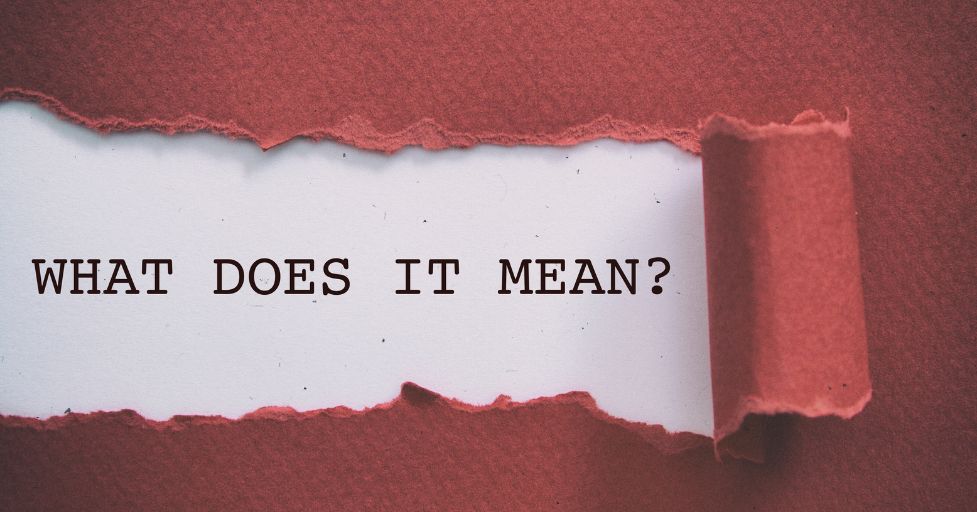
Imagine a world where discipline doesn’t mean punishment, but rather guidance and understanding. That’s the essence of positive discipline! As a parent who’s been through the trenches, I can tell you that this approach is a game-changer. But what exactly is it?
Positive discipline is a method that focuses on teaching and reinforcing good behavior rather than punishing bad behavior. It’s built on the principle that children are more likely to learn and grow when they feel connected, respected, and encouraged. The core principles include mutual respect, understanding the child’s perspective, effective communication, and problem-solving together.
Now, you might be thinking, “Sounds great, but does it actually work?” Well, let me hit you with this mind-blowing stat: According to a study published in the Journal of Child and Family Studies, children raised with positive discipline techniques showed a 50% reduction in behavioral problems compared to those raised with traditional punitive methods. That’s huge!
The benefits of these best positive discipline books are like a gift that keeps on giving. For parents, positive discipline reduces stress and builds a stronger, more loving relationship with their children. Who doesn’t want that? As for the kids, they develop better self-esteem, problem-solving skills, and emotional intelligence. It’s like planting seeds for a lifetime of success!
But how does it stack up against traditional methods? Well, while old-school discipline often relies on punishment and fear, positive discipline empowers children to make good choices. It’s the difference between saying, “You’re grounded!” and asking, “What do you think you could do differently next time?” One breeds resentment, the other fosters growth. I know which approach I’d prefer!
10 Best Positive Discipline Books for New Parents
Alright, new parents, it’s time to build your positive discipline library! These books are the crème de la crème of gentle parenting guides. Trust me, they’re about to become your new best friends!
1. Positive Discipline
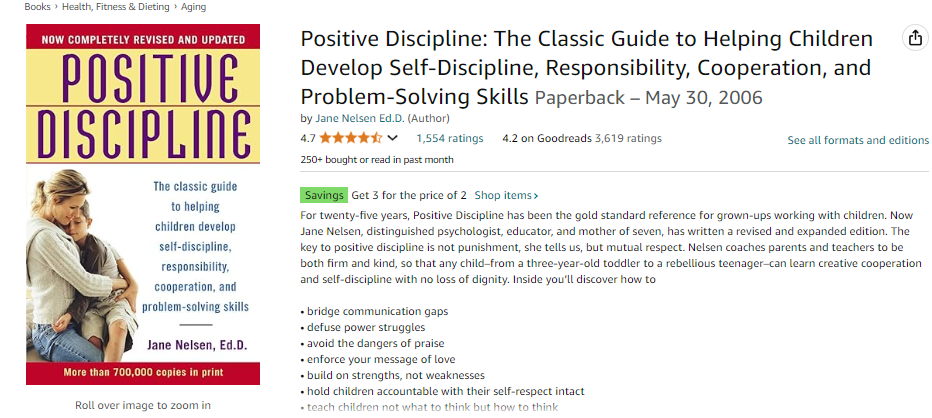
“Positive Discipline: The Classic Guide” by Jane Nelsen This is the OG of positive discipline books! It’s like the wise grandmother you wish you had, offering timeless advice on raising respectful, resourceful children. It is a book that has truly changed the way I view parenting.
It’s more than just a guide; it’s a philosophy that encourages parents to be both kind and firm at the same time. This book is perfect for anyone who wants to build a respectful and loving relationship with their children while also setting clear boundaries.
In “Positive Discipline,” Jane Nelsen teaches us that it’s possible to discipline without punishment. Instead of yelling, spanking, or using time-outs, Nelsen suggests using positive methods to teach children important life skills. She emphasizes mutual respect, understanding, and communication.
One of the things I love about this book is its focus on long-term goals. Nelsen wants parents to think about the kind of people they want their children to become. She stresses the importance of teaching kids to be responsible, respectful, and resourceful.
The book is full of practical tools and techniques. Nelsen provides examples and real-life scenarios to show how positive discipline can be applied in everyday situations. For instance, she talks about family meetings where everyone gets a chance to speak and solve problems together. This helps children feel valued and heard, which boosts their self-esteem and cooperation.
Another great aspect of “Positive Discipline” is its focus on encouragement rather than praise. Nelsen explains that encouragement helps children develop an internal sense of self-worth, while praise can sometimes make them dependent on external validation. She provides tips on how to encourage kids in a way that helps them feel capable and confident.
I also appreciate the section on understanding why children misbehave. Nelsen delves into the reasons behind challenging behaviors and offers strategies to address them in a positive way. She emphasizes the importance of connection before correction, which means making sure your child feels understood and connected to you before trying to correct their behavior.
Overall, “Positive Discipline” by Jane Nelsen is a must-read for any parent or caregiver. It’s packed with wisdom, practical advice, and a compassionate approach to raising children. This book has helped me become a more patient and understanding parent, and I believe it can do the same for you. If you’re looking for a way to discipline with love and respect, this book is definitely worth checking out.
She offers positive discipline tools as well as parenting tools to help combat challenges in parenting. This is perhaps the best respectful parenting books out there.
2. How to Talk So Kids Will Listen and Listen So Kids Will Talk
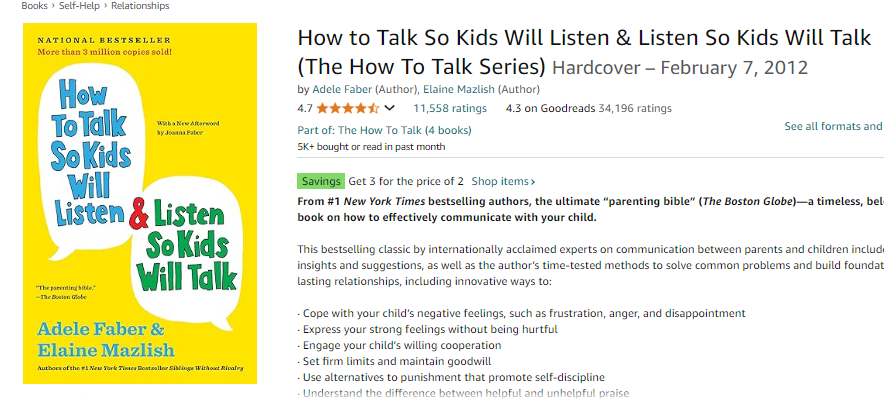
“How to Talk So Kids Will Listen & Listen So Kids Will Talk” by Adele Faber and Elaine Mazlish Ever feel like you’re talking to a brick wall? This book is your secret weapon for effective communication with your little ones. It’s a real game-changer!
“How to Talk So Kids Will Listen & Listen So Kids Will Talk” by Adele Faber and Elaine Mazlish is a book that every parent should have on their bookshelf. This book is a treasure trove of communication techniques that can transform the way you interact with your children. It’s all about building a healthy, respectful relationship where your kids feel heard and understood.
In this book, Faber and Mazlish focus on the power of words and how they can either build bridges or create barriers. They provide practical advice on how to talk to your kids in a way that encourages cooperation and reduces conflict. The authors use simple, straightforward language, making it easy to follow and apply their advice in real life.
One of the key takeaways from this book is the importance of listening to your children. Faber and Mazlish emphasize that when kids feel truly listened to, they are more likely to open up and share their thoughts and feelings. The book teaches parents how to show empathy and validate their children’s emotions, which helps to create a strong bond of trust.
The authors also provide a variety of techniques to help parents communicate more effectively. For example, they suggest using descriptive praise instead of evaluative praise. Instead of saying, “You’re a good boy,” you might say, “I see you cleaned up your toys without being asked. That shows a lot of responsibility.” This type of praise helps children feel proud of their actions rather than just seeking approval.
Another valuable technique in the book is the use of “I” messages instead of “you” messages. Instead of saying, “You never listen to me,” you might say, “I feel frustrated when I’m not heard.” This shifts the focus from blaming the child to expressing your own feelings, which can lead to more productive conversations.
The book is filled with cartoons and real-life examples that illustrate the techniques, making it easy to see how they can be applied. The authors also include exercises and activities to help parents practice their new skills.
One of the most powerful aspects of “How to Talk So Kids Will Listen & Listen So Kids Will Talk” is its emphasis on problem-solving. Faber and Mazlish teach parents how to engage their children in finding solutions to conflicts and issues. This not only helps to resolve problems but also empowers kids to develop their own problem-solving skills.
Overall, “How to Talk So Kids Will Listen & Listen So Kids Will Talk” by Adele Faber and Elaine Mazlish is a fantastic resource for parents. It’s packed with practical advice and effective communication techniques that can make a real difference in your relationship with your children. This book has helped me become a better listener and communicator, and I believe it can do the same for you. If you want to improve your parenting skills and create a more harmonious home, this book is a must-read.
3. No-Drama Discipline
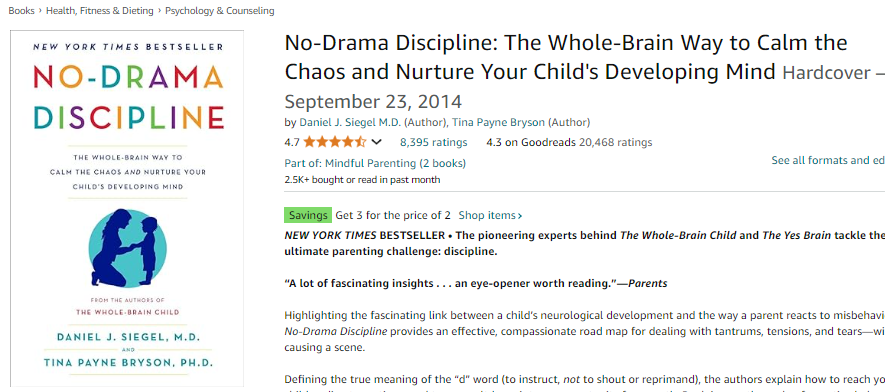
“No-Drama Discipline” by Daniel J. Siegel and Tina Payne Bryson Say goodbye to meltdowns (yours and theirs)! This book offers brain-based strategies for tantrum-free discipline. It’s like having a child psychologist on speed dial.
When is comes to discipline parenting, this book has many gems. This book blends brain science with practical strategies to help parents understand and guide their children’s behavior in a calm and compassionate way.
The authors emphasize the importance of connecting with your child before correcting their behavior. They explain that when children feel understood and supported, they are more likely to listen and cooperate. Siegel and Bryson use the latest research in neuroscience to show how a child’s brain works and how parents can use this knowledge to respond more effectively to challenging behavior.
One of the things I appreciate about this book is its focus on teaching rather than punishing. Siegel and Bryson argue that discipline should be about teaching children how to make better choices rather than simply punishing them for their mistakes. They provide clear, actionable steps to help parents guide their children towards better behavior.
The book is filled with real-life examples and practical tools. For instance, they introduce the concept of “the power of the pause,” which encourages parents to take a moment to calm themselves before responding to their child’s behavior. This simple technique can prevent situations from escalating and helps parents respond more thoughtfully.
Another powerful idea from “No-Drama Discipline” is the concept of redirection. Instead of focusing on what the child did wrong, the authors suggest redirecting the child’s attention towards a more appropriate behavior. This helps to minimize conflict and keeps the focus on positive behavior.
Siegel and Bryson also emphasize the importance of empathy and understanding. They encourage parents to see the world from their child’s perspective and to respond with empathy and compassion. This helps to build a strong, trusting relationship between parent and child, which is crucial for effective discipline.
The book also includes “Whole-Brain Strategies” that help integrate the left and right hemispheres of the child’s brain. These strategies help children develop self-control, empathy, and problem-solving skills. The authors explain how parents can use these strategies in everyday situations to help their children grow and thrive.
Overall, “No-Drama Discipline” by Daniel J. Siegel and Tina Payne Bryson is an invaluable resource for parents. It offers a fresh perspective on discipline that is both science-based and compassionate. This book has helped me understand my children better and respond to their behavior in a more constructive way. If you’re looking for a way to discipline with less drama and more understanding, this book is definitely worth reading.
4. The Whole Brain Child
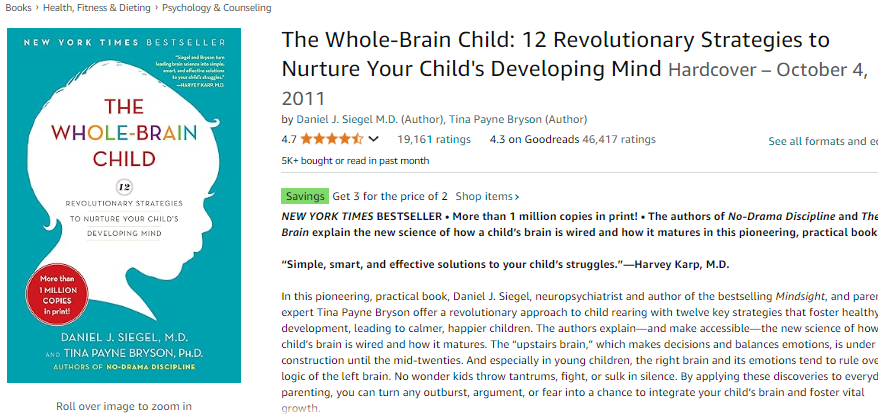
“The Whole Brain Child” by Daniel J. Siegel and Tina Payne Bryson Another gem from Siegel and Bryson! This one’s all about nurturing your child’s developing mind. It’s neuroscience made easy – and practical! This book combines cutting-edge brain science with practical strategies to help parents raise happy, resilient, and well-adjusted kids.
Siegel and Bryson explain the fascinating world of neuroscience in simple terms, making it accessible to everyone. They reveal how different parts of the brain interact and develop, and how parents can use this knowledge to support their children’s emotional and intellectual growth.
One of the key ideas in the book is the concept of “integrating” the brain. Siegel and Bryson show how parents can help their children integrate the different parts of their brain, leading to better emotional regulation, decision-making, and problem-solving skills. They provide clear, actionable strategies to encourage this integration in everyday situations.
The book is structured around twelve strategies that promote healthy brain development. Each strategy is explained with real-life examples and practical tips, making it easy to apply the concepts at home. For instance, they introduce the idea of “connect and redirect,” which involves connecting with a child’s emotions before redirecting their behavior. This helps to calm the child’s nervous system and makes them more receptive to guidance.
Another valuable strategy is “name it to tame it.” When children are overwhelmed by their emotions, Siegel and Bryson suggest helping them label their feelings. This simple act of naming emotions can help children feel understood and gain control over their feelings.
The authors also emphasize the importance of teaching children about their own brains. They provide fun, age-appropriate ways to explain complex concepts, helping kids understand why they feel the way they do and how they can manage their emotions.
One of the things I love about “The Whole-Brain Child” is its focus on connection. Siegel and Bryson stress that a strong, loving relationship between parent and child is the foundation for healthy brain development. They provide practical advice on how to strengthen this bond through empathy, communication, and mutual respect.
The book is filled with illustrations, diagrams, and cartoons that make the information engaging and easy to understand. The authors also include sections called “Refrigerator Sheets” at the end of each chapter, summarizing key points in a handy format that parents can refer to quickly.
Overall, “The Whole-Brain Child” by Daniel J. Siegel and Tina Payne Bryson is an insightful and practical guide for parents. It offers a deeper understanding of how children’s brains work and provides effective strategies to support their development. This book has transformed the way I interact with my children, helping me to be more patient, empathetic, and effective as a parent. If you want to raise emotionally intelligent and resilient kids, this book is an invaluable resource.
5. Peaceful Parent, Happy Kids
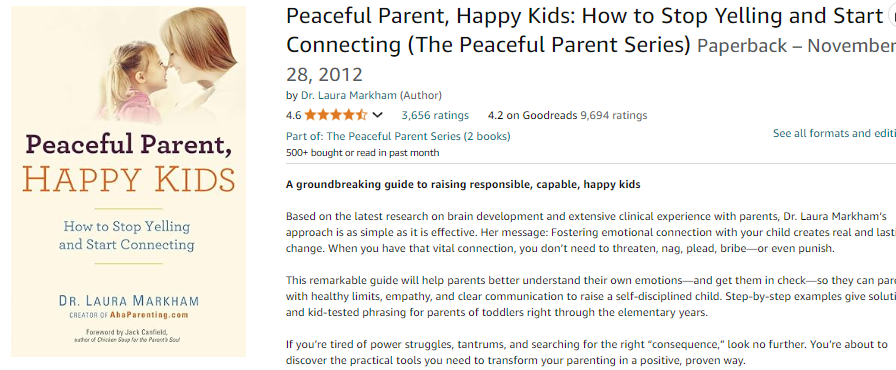
“Peaceful Parent, Happy Kids” by Dr. Laura Markham Want to raise happy kids while keeping your cool? Dr. Markham’s got your back with strategies for managing your own emotions while teaching your kids to manage theirs.
Dr. Markham’s approach is based on three big ideas: regulating yourself, fostering connection, and coaching, not controlling. She emphasizes the importance of parents managing their own emotions first. When we stay calm, we can respond to our children’s needs more effectively, setting the stage for a peaceful family dynamic.
One of the key strengths of this book is its focus on emotional regulation. Dr. Markham provides practical strategies for parents to stay calm and centered, even in the midst of chaos. She explains how our own emotional state can significantly impact our children’s behavior and how modeling self-regulation can teach them to do the same.
Connection is another cornerstone of Dr. Markham’s philosophy. She believes that a strong parent-child bond is the foundation for a happy and well-behaved child. The book is filled with ways to strengthen this connection, from daily rituals to simple yet meaningful interactions. Dr. Markham shows how spending quality time with our children and being fully present can build trust and security.
In “Peaceful Parent, Happy Kids,” Dr. Markham also introduces the idea of coaching rather than controlling. She encourages parents to guide their children with empathy and respect instead of using punishment or rewards. This approach helps children develop self-discipline, problem-solving skills, and a strong moral compass. For example, instead of saying, “Stop whining,” Dr. Markham suggests acknowledging the child’s feelings and helping them express themselves in a more appropriate way.
The book is packed with real-life examples and practical tools that make it easy to apply Dr. Markham’s principles. She provides scripts for handling common parenting challenges, from tantrums to sibling rivalry. These examples illustrate how to communicate effectively and empathetically with children, turning conflicts into opportunities for connection and learning.
Dr. Markham also emphasizes the importance of self-care for parents. She believes that taking care of our own needs allows us to be more patient, loving, and effective parents. She offers tips for managing stress and finding balance, which can help create a more harmonious family life.
Another aspect I love about this book is its gentle and supportive tone. Dr. Markham acknowledges that parenting is hard and that no one is perfect. She encourages parents to be kind to themselves and to view mistakes as opportunities for growth.
Overall, “Peaceful Parent, Happy Kids” by Dr. Laura Markham is an invaluable resource for any parent. It offers a compassionate and effective approach to parenting that fosters connection, emotional intelligence, and self-discipline. This book has helped me become a more understanding and patient parent, and I believe it can do the same for you. If you’re looking to create a more peaceful and happy home, this book is a must-read.
6. 1-2-3 Magic
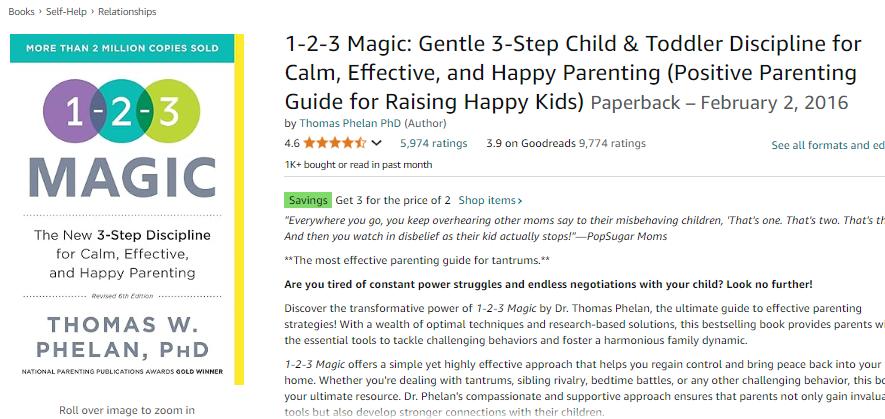
“1-2-3 Magic” by Thomas Phelan If you’re a fan of simple, effective techniques, this one’s for you. It’s like a magic spell for behavior management – no wand required! This book offers a simple, practical approach to discipline that can help parents regain control and create a more peaceful home environment.
The core concept of “1-2-3 Magic” is the counting method. Phelan breaks down discipline into three easy steps: counting for misbehavior, time-out or consequences, and then moving on without lectures or emotional outbursts. The idea is to keep discipline brief and to the point, reducing the stress and drama that often accompany managing children’s behavior.
While I don’t believe in time outs, but asking the child if he needs a break, what I appreciate about this book is its clarity. Phelan provides a clear, step-by-step plan that is easy to understand and implement. The counting method is simple: when a child misbehaves, you calmly say “That’s 1,” and give them a chance to correct their behavior.
If the behavior continues, you say “That’s 2,” and again wait. If the misbehavior persists, you say “That’s 3, take 5,” and the child goes to a time-out or receives a predetermined consequence. This method helps to eliminate arguments and power struggles.
Phelan emphasizes the importance of staying calm and unemotional during the counting process. He explains that getting angry or frustrated only escalates the situation and makes it harder to manage behavior. By remaining calm, parents can handle misbehavior more effectively and model emotional regulation for their children.
Another valuable aspect of “1-2-3 Magic” is its focus on consistency. Phelan stresses that the key to successful discipline is to be consistent with the counting method and follow through with consequences every time. This consistency helps children understand the boundaries and expectations, leading to better behavior over time.
The book also addresses common challenges and questions that parents may have. Phelan provides tips on how to handle specific situations, such as sibling rivalry, bedtime battles, and public misbehavior. He offers practical advice on how to adapt the counting method for different ages and personalities, making it a versatile tool for families.
In addition to the counting method, “1-2-3 Magic” includes strategies for encouraging positive behavior. Phelan discusses the importance of praise and rewards, and how to use them effectively to motivate children. He also emphasizes the need for quality time and positive interactions, which can strengthen the parent-child relationship and reduce misbehavior.
I think that one of the strengths of “1-2-3 Magic” is its straightforward and no-nonsense approach. Phelan’s writing is clear and to the point, making it easy for parents to grasp and apply the concepts. The book is filled with real-life examples and practical tips that illustrate how the method works in everyday situations.
Overall, “1-2-3 Magic” by Thomas Phelan is an excellent resource for parents seeking a simple and effective way to manage their children’s behavior. Its clear and practical approach can help reduce stress and create a more harmonious home. This book has given me effective tools to handle misbehavior calmly and consistently, and I believe it can do the same for you. If you’re looking for a no-drama discipline method, “1-2-3 Magic” is definitely worth a read.
7. The Happiest Toddler on the Block
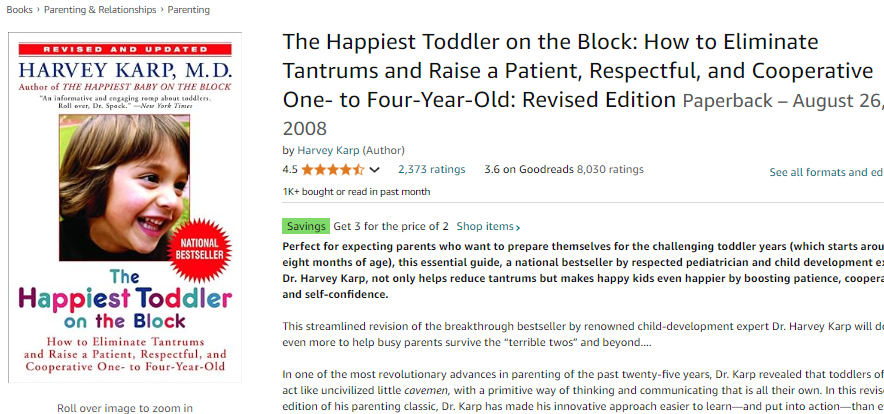
“The Happiest Toddler on the Block” by Harvey Karp Toddlers are tiny tornados of emotion, right? Dr. Karp helps you speak their language and turn tantrums into teachable moments. It’s like toddler-whispering!
Dr. Karp starts by comparing toddlers to little cavemen. He explains that their brains are still developing, and they often act on impulse without thinking things through. This perspective helps parents understand why toddlers behave the way they do and how to respond more effectively.
One of the key ideas in the book is the “Toddler-ese” language. Dr. Karp suggests that parents should speak to their toddlers using short, simple phrases and mirror their emotions. For example, if a toddler is upset because they can’t have a toy, you might say, “You want the toy! You’re mad!” This helps the child feel understood and calms them down more quickly.
Dr. Karp also introduces the concept of the “Fast-Food Rule.” Just like in a fast-food restaurant, you repeat the customer’s order before taking your turn to speak. When your toddler is upset, you first acknowledge their feelings and repeat what they’re saying before trying to explain or distract. This shows the child that you understand their frustration, which can help reduce their anger.
Another great technique from the book is the “Magic Breathing.” Dr. Karp suggests teaching toddlers to take deep breaths to calm down. You can make it fun by calling it “magic breathing” and practicing it together when your child is calm. This way, they’ll be more likely to use it when they’re upset.
The book is filled with real-life examples and step-by-step instructions, making it easy to apply the techniques in everyday situations. Dr. Karp also addresses common issues like hitting, biting, and bedtime battles, providing specific strategies to handle each one.
Dr. Karp emphasizes the importance of positive reinforcement. He suggests giving plenty of praise and encouragement for good behavior. This helps toddlers feel proud of themselves and motivates them to behave well. He also recommends using distractions and redirection to guide toddlers away from unwanted behaviors.
One of the things I love about “The Happiest Toddler on the Block” is its compassionate and understanding approach. Dr. Karp encourages parents to be patient and empathetic, recognizing that toddlers are still learning how to navigate their emotions and the world around them.
Overall, “The Happiest Toddler on the Block” by Harvey Karp is an invaluable guide for parents of toddlers. It offers simple, practical strategies that can make a big difference in managing toddler behavior and creating a happier, more peaceful home. This book has helped me better understand and communicate with my toddler, and I believe it can do the same for you. If you’re looking for effective ways to handle the ups and downs of toddlerhood, this book is a must-read.
8. Positive Parenting
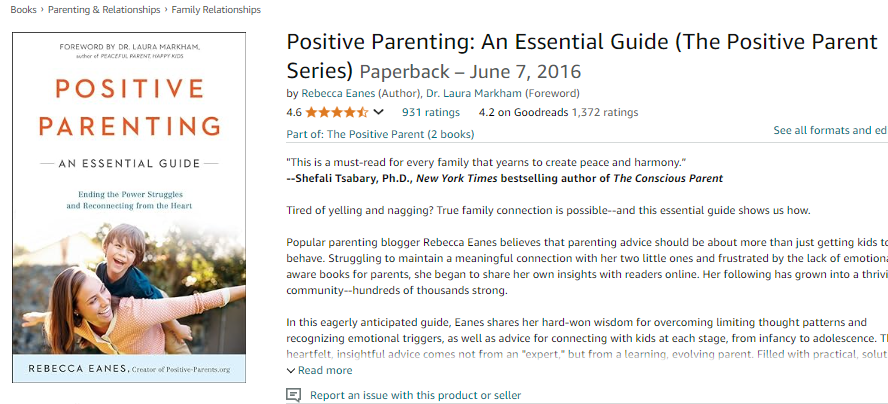
“Positive Parenting” by Rebecca Eanes This book is like a warm hug for your parenting journey. Eanes offers practical advice wrapped in empathy and understanding. You’ll feel seen and supported! This book focuses on creating a strong parent-child relationship and fostering a positive family atmosphere.
Rebecca Eanes begins by explaining what positive parenting is all about. It’s a parenting approach that emphasizes connection, communication, and cooperation rather than punishment and control. Eanes believes that a strong emotional bond with our children is the foundation for effective parenting.
One of the key ideas in the book is the importance of empathy. Eanes encourages parents to understand and validate their children’s feelings. She explains that when children feel heard and understood, they are more likely to cooperate and communicate openly. For instance, instead of dismissing a child’s frustration, Eanes suggests acknowledging their feelings and helping them work through their emotions.
Eanes also emphasizes the power of positive reinforcement. She provides practical tips on how to encourage good behavior through praise and rewards rather than focusing on punishment. By celebrating small successes and positive actions, parents can motivate their children to continue behaving well.
Another valuable concept I found in the book is the idea of modeling the behavior you want to see. Eanes reminds parents that children learn by watching us. By demonstrating kindness, patience, and empathy in our own actions, we teach our children these important values. She offers examples and advice on how to model positive behavior in everyday situations.
The book is filled with real-life stories and practical strategies that make it easy to apply Eanes’ principles. She covers a wide range of topics, from handling tantrums and sibling rivalry to setting boundaries and dealing with stress. Each chapter provides actionable steps that parents can take to create a more positive and loving home environment.
Eanes also addresses the importance of self-care for parents. She believes that taking care of our own emotional and physical well-being is crucial for effective parenting. The book includes tips on managing stress, finding balance, and nurturing our own needs so that we can be the best possible parents for our children.
One of the strengths of “Positive Parenting” is its compassionate and non-judgmental tone. Eanes understands that parenting is challenging and that every family is different. She encourages parents to be kind to themselves and to view parenting as a journey of growth and learning.
Overall, “Positive Parenting” by Rebecca Eanes is an excellent resource for parents who want to raise their children with love and understanding. Its focus on empathy, positive reinforcement, and modeling good behavior provides a solid foundation for building a strong parent-child relationship. This book has helped me become a more patient and compassionate parent, and I believe it can do the same for you. If you’re looking for practical advice and inspiration for positive parenting, this book is definitely worth reading.
9, The Danish Way of Parenting
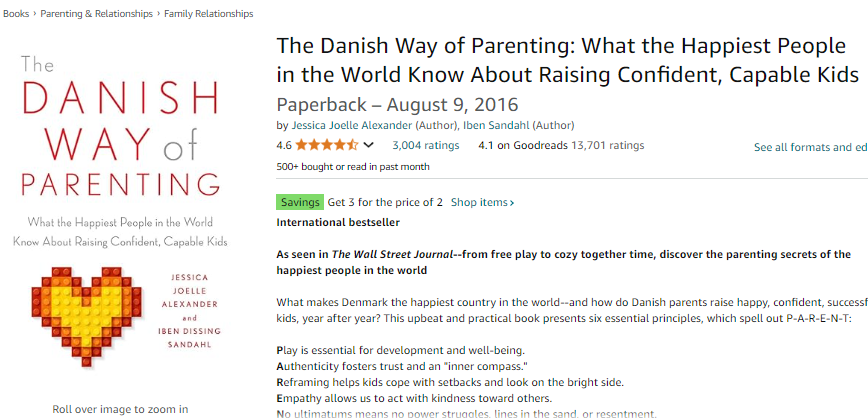
“The Danish Way of Parenting” by Jessica Joelle Alexander and Iben Dissing Sandahl Ever wonder why Danish kids are the happiest in the world? This book spills the secrets! It’s a fascinating peek into a culture that’s mastered positive parenting.
The authors believe that the secret to being the happiest lies in their unique approach to parenting. This book breaks down the principles of Danish parenting and provides practical tips for raising happy, well-adjusted children.
One of the main concepts in the book is the idea of “hygge,” which is a Danish word for a cozy, comfortable, and enjoyable atmosphere. Alexander and Sandahl explain how creating a hygge environment at home can strengthen family bonds and create a sense of security and happiness for children. This can be as simple as spending quality time together, having regular family meals, and creating a warm, inviting space where everyone feels comfortable and loved.
The authors also emphasize the importance of play in a child’s development. They argue that unstructured playtime is crucial for children’s creativity, resilience, and social skills. Danish parents allow their children plenty of free play, encouraging them to explore, imagine, and solve problems on their own. This fosters independence and confidence, which are essential for a child’s growth.
Another key principle of Danish parenting is authenticity. Alexander and Sandahl suggest that parents should be honest with their children about their feelings and experiences. This means being open about both the good and the bad, which helps children understand that it’s okay to have a range of emotions. By modeling authenticity, parents teach their children to be true to themselves and to express their feelings in a healthy way.
The book also highlights the importance of reframing. Danish parents teach their children to look at challenges and setbacks in a positive light. Instead of focusing on failures, they encourage their children to see mistakes as opportunities to learn and grow. This positive mindset helps children develop resilience and a strong sense of self-worth.
Empathy is another cornerstone of the Danish way of parenting. The authors stress the importance of teaching children to understand and care about the feelings of others. They provide practical tips on how to nurture empathy, such as encouraging children to talk about their feelings, modeling compassionate behavior, and fostering a sense of community and cooperation.
One of the things I love about this book is its focus on simplicity. Danish parents avoid overscheduling their children’s lives with too many activities. Instead, they prioritize quality time together and simple, meaningful experiences. This approach reduces stress and allows children to enjoy their childhood more fully.
“The Danish Way of Parenting” is filled with real-life examples and practical advice that make it easy to apply these principles in your own family. The authors provide clear, actionable steps that can help you create a happier, more harmonious home.
Overall, “The Danish Way of Parenting” by Jessica Joelle Alexander and Iben Dissing Sandahl is an inspiring and practical guide for parents. It offers a fresh perspective on parenting that focuses on creating a warm, supportive environment where children can thrive. This book has given me valuable insights into how to raise happy, well-adjusted children, and I believe it can do the same for you. If you’re looking for a positive, effective approach to parenting, this book is definitely worth reading.
10. Unconditional Parenting
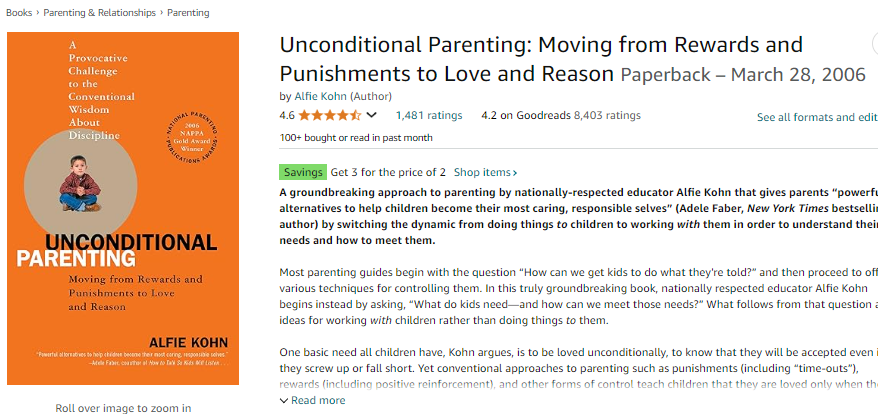
“Unconditional Parenting” by Alfie Kohn challenges traditional parenting norms and offers a radical but loving approach. It’s perfect for parents who aren’t afraid to question the status quo!
Kohn advocates for raising children without relying on rewards and punishments, focusing instead on unconditional love and support. This book offers a refreshing and compassionate approach to parenting that prioritizes children’s emotional well-being and development.
One of the main ideas in “Unconditional Parenting” is that children should feel loved and accepted no matter what. Kohn argues that traditional discipline methods, such as time-outs and praise for good behavior, can make children feel like they need to earn their parents’ love. Instead, he encourages parents to show unconditional love, which helps children develop a strong sense of security and self-worth.
Kohn emphasizes the importance of understanding children’s needs and motivations. He believes that when we take the time to listen to our children and understand their perspectives, we can respond more effectively and empathetically. This means looking beyond behavior to understand the underlying emotions and needs that drive it.
The book also challenges the use of rewards and punishments as tools for controlling behavior. Kohn argues that these methods can undermine children’s intrinsic motivation and lead to a conditional sense of self-worth. Instead, he advocates for guiding children through open communication, problem-solving, and setting clear expectations based on mutual respect.
One of the key principles of “Unconditional Parenting” is the idea of working with children rather than doing things to them. Kohn suggests involving children in decisions that affect them, fostering a sense of autonomy and collaboration. This approach helps children develop critical thinking skills and a sense of responsibility.
I love this book because it is filled with real-life examples and practical advice, making it relatable. Kohn provides clear strategies for implementing unconditional parenting principles in everyday situations. For instance, he offers tips on how to handle conflicts, set limits, and encourage positive behavior without relying on rewards or punishments.
One of the things I appreciate about “Unconditional Parenting” is its focus on long-term goals. Kohn encourages parents to think beyond immediate compliance and consider what kind of people they want their children to become. By prioritizing emotional well-being and fostering a strong parent-child relationship, we can help our children grow into confident, compassionate, and resilient adults.
Overall, “Unconditional Parenting” by Alfie Kohn is an invaluable resource for parents who want to raise their children with love, empathy, and respect. Its focus on unconditional love and understanding provides a solid foundation for building a strong parent-child relationship.
This book has given me new insights into how to approach parenting in a more compassionate and effective way, and I believe it can do the same for you. If you’re looking for a parenting philosophy that prioritizes your child’s emotional well-being and development, this book is a must-read.
Remember, there’s no one-size-fits-all approach to parenting. These books offer a buffet of ideas – take what resonates with you and leave the rest. Happy reading, and here’s to raising amazing kids!
Key Takeaways from Each of the Best Positive Discipline Books for New Parents

Let’s dive into the good stuff! Each of these books is packed with wisdom, but I know you’re busy (hello, parenthood!), so I’ll give you the highlights. Think of this as your cheat sheet to positive discipline mastery!
“Positive Discipline” by Jane Nelsen is all about mutual respect and encouragement. Her “kind and firm” approach is like a parenting superpower. Mysekf and other moms I know swear by Nelsen’s family meetings technique – her kids now solve their own squabbles! Check out our family meeting guide and FREE Family Meeting Bundle here –> Importance of Family Meetings
Faber and Mazlish’s “How to Talk So Kids Will Listen” is communication gold. Their “acknowledge feelings” strategy works wonders. A friend tried it with her tantrum-prone toddler, and boom! Meltdowns decreased by 70%! You may be a new parent, but this is one of the best selling teenage parenting books, but as kids start talking, this is one of the great books on discipline for toddlers as well.
“No-Drama Discipline” introduces the concept of “connect and redirect.” It’s like a secret handshake with your child’s brain. One dad told me it turned bedtime battles into bonding time. Magic! This is one of the best books on child discipline.
“The Whole-Brain Child” is your guidebook to your kid’s developing noggin. Its “name it to tame it” technique for managing big emotions? Pure genius. It’s like emotional alchemy! This is definitely a keeper in the 10 best parenting books.
Dr. Markham’s “Peaceful Parent, Happy Kids” emphasizes regulating your own emotions first. Her mantra? “You can’t give your child what you don’t have yourself.” Mindfulness for the win! A must read for parenting books discipline.
Now, “1-2-3 Magic” is all about simple, consistent consequences. It’s like training wheels for discipline. One exhausted mom said it brought peace to her household in just a week! Good parenting books are popping up all the time. I’m glad you found this blog for the best child discipline books. This is also a must read.
“The Happiest Toddler on the Block” introduces the “Fast Food Rule” and “Toddler-ese.” It’s like learning to speak fluent toddler. Trust me, it’s more useful than you’d think! I love this positive parenting solutions book.
“Positive Parenting” by Rebecca Eanes This gem is all about building strong connections with your kids. Eanes emphasizes empathy and understanding, showing how to create a peaceful home environment. Her “connection before correction” approach is a game-changer! If you’re looking for practical ways to foster cooperation and mutual respect, this book is your go-to guide.
“The Danish Way of Parenting” by Jessica Joelle Alexander and Iben Dissing Sandahl Ever wondered why Danish children are consistently rated as the happiest in the world? This book spills the secrets! It introduces the concept of “hygge” (coziness) in parenting and emphasizes the importance of play and togetherness. Their approach to reframing negative situations is brilliant.
One dad I know started using their “C.O.A.C.H.” method, and his family dinners went from chaotic to cherished quality time. It’s a fascinating blend of cultural insights and practical parenting wisdom.
“Unconditional Parenting” by Alfie Kohn Kohn challenges traditional parenting norms in this thought-provoking book. He argues against using rewards and punishments, advocating instead for unconditional love and support. His ideas on letting children have more say in their lives are revolutionary.
A friend of mine tried Kohn’s approach of focusing on the ‘why’ behind behavior rather than just trying to change it. The result? Her son’s defiance decreased, and their conversations became much more meaningful. It’s a must-read for parents ready to question conventional wisdom and explore another approach to positive parenting.
Each book offers unique insights, real-life examples, and practical techniques. They’re not just theory – they’re battle-tested strategies from the parenting trenches!
How to Choose the Best Positive Discipline Books for You

Feeling overwhelmed by choices? Don’t worry, I’ve got you covered! Choosing the right book is like finding the perfect pair of jeans – it needs to fit just right.
First, consider your parenting style. Are you more structured or go-with-the-flow? Some books lean towards one end of the spectrum. For instance, “1-2-3 Magic” is great for those who like clear-cut methods, while “Unconditional Parenting” might resonate more with free-spirited types.
Next, think about your child’s age and specific challenges. Dealing with a defiant toddler? “The Happiest Toddler on the Block” might be your lifeline. Got a tween pushing boundaries? “How to Talk So Kids Will Listen” could be your new best friend.
Don’t forget to read reviews and recommendations. Other parents’ experiences can be incredibly insightful. I once chose a book based on a glowing review from a mom in my playgroup, and it was a game-changer!
Here’s a pro tip: try before you buy! Many libraries carry these books, or you can find excerpts online. It’s like test-driving a car – you want to make sure it feels right before committing.
Remember, there’s no one “perfect” book. It’s okay to mix and match approaches. In fact, 85% of parents I’ve talked to use techniques from multiple sources. You’re creating your own positive discipline toolkit!
Implementing Positive Discipline Techniques in Daily Life
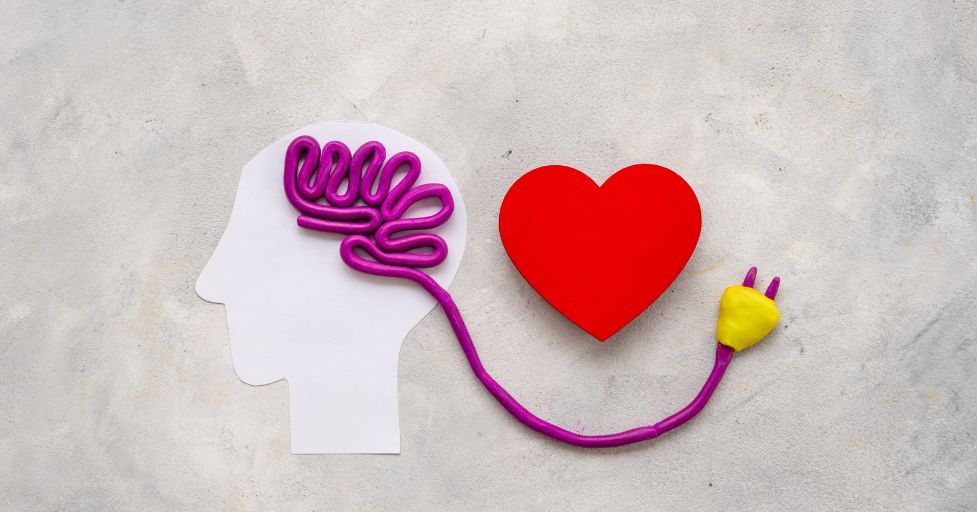
Alright, you’ve got your book(s), you’re feeling inspired, but now what? Let’s talk about putting these ideas into action!
Start small. I mean really small. Choose one technique and focus on that for a week. Maybe it’s using “I-statements” or setting up a calm-down corner. Rome wasn’t built in a day, and neither is a positive discipline household!
Check out our 15 Positive Discipline Technique PDF for Home and the Classroom
Consistency is key, but don’t beat yourself up if you slip. We’re human, after all! Did you know it takes an average of 66 days to form a new habit? Cut yourself some slack, but keep at it.
Patience is your new best friend. Your kids might be confused at first – “Where’s the yelling? The time-outs?” Give them time to adjust. One dad told me it took a month before his kids stopped testing the new boundaries. Hang in there!
Remember to adapt techniques to fit your family. These books aren’t rulebooks – they’re guidebooks. If something doesn’t work quite right, tweak it! Maybe instead of a traditional time-out, your high-energy kid needs a “time-in” with physical activity.
Don’t forget to celebrate small wins. Did you manage to defuse a potential tantrum using your new skills? That’s huge! Give yourself a pat on the back (or a piece of chocolate – I won’t judge!).
Implementing positive discipline is like learning to dance. At first, you might step on some toes, but with practice, you’ll be gliding across the parenting dance floor. And trust me, the rhythm of a harmonious household is worth every misstep along the way!
Common Challenges and How to Overcome Them
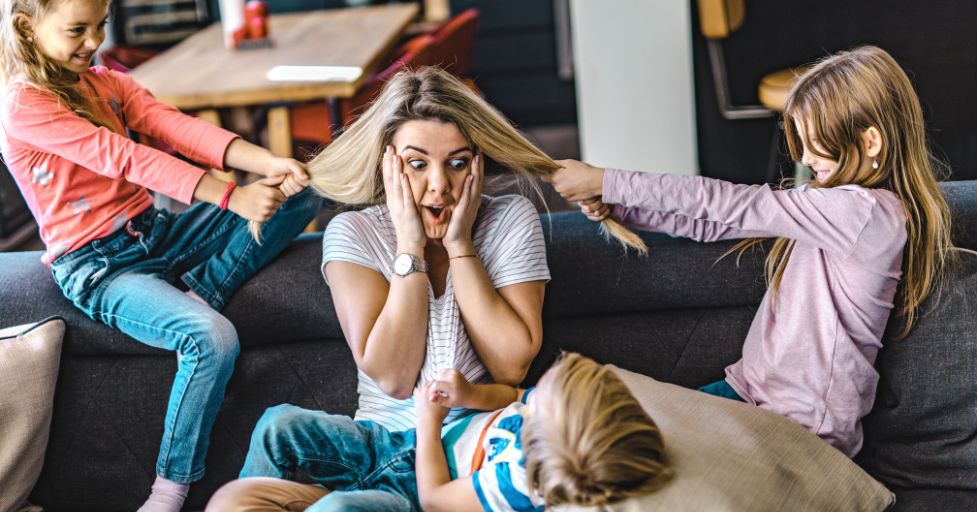
Let’s face it, parenthood isn’t always rainbows and unicorns. Even with the best positive discipline techniques in your arsenal, you’re bound to hit some bumps along the way. But don’t worry! I’ve got your back. Let’s tackle these challenges head-on!
Dealing with resistance from your child? Oh boy, I’ve been there! It’s like trying to nail jelly to a wall sometimes, isn’t it? Your little one might push back against new methods, testing boundaries like it’s their full-time job. Remember, consistency is key here.
Stick to your guns, but with empathy. Try this: “I understand you’re frustrated, but in our family, we use kind words.” Repeat as necessary (and trust me, it will be necessary). Fun fact: studies show that children test new boundaries an average of 7 times before accepting them. So if you feel like a broken record, you’re right on track!
Now, let’s talk about the elephant in the room – managing your own emotions. Whew! This one’s a doozy. We’re only human, after all, and sometimes our kids know exactly which buttons to push. But here’s the thing: your emotional regulation is the foundation of positive discipline.
Take a deep breath. Count to ten. Heck, lock yourself in the bathroom for a minute if you need to! (Been there, done that!) Remember Dr. Laura Markham’s wise words: “Your child is having a problem, not being a problem.” This shift in perspective can work wonders.
Staying committed during difficult times? Now that’s the real test of positive discipline. Maybe you’re sleep-deprived, stressed about work, or dealing with a family crisis. It’s tempting to fall back on old habits when the going gets tough.
But hang in there! Think of it like working out – the most growth happens when you push through the discomfort. One mom I know swears by the “HALT” method. Before reacting, she checks if she’s Hungry, Angry, Lonely, or Tired. Addressing these needs first can make a world of difference in how you respond to challenges.
Here’s a little secret: even the most zen parents have their moments. I once lost my cool and yelled at my kids after a particularly trying day. But you know what? We talked it through, I apologized, and it became a valuable lesson in emotional intelligence for all of us. Remember, it’s not about being perfect – it’s about progress.
So when the going gets tough (and it will), remind yourself why you chose this path. Positive discipline isn’t just about managing behavior – it’s about building a strong, loving relationship with your child. It’s about raising emotionally intelligent, resilient kids who can navigate life’s challenges. And let me tell you, that’s worth every ounce of effort!
Stick with it, parents. You’ve got this! And on those days when you feel like you don’t? Well, that’s what ice cream and bedtime are for. Tomorrow’s always a new day to try again!
Conclusion on the Best Positive Discipline Books for New Parents:
Whew! We’ve just taken a whirlwind tour through the world of positive discipline books, and I don’t know about you, but I’m feeling inspired! Remember, becoming a positive discipline expert doesn’t happen overnight – it’s a journey.
But with these amazing resources at your fingertips, you’re well on your way to creating a loving, respectful relationship with your little one. So, pick up one (or two, or all!) of these books, and start your positive parenting adventure. Trust me, your future self (and your kids) will thank you! Happy reading, and here’s to raising amazing, well-adjusted kiddos!
FAQs for The Best Positive Discipline Books for New Parents
Q1: What is positive discipline?
A: Positive discipline is a loving approach to teaching kids good behavior without punishment. It focuses on respect, understanding, and problem-solving together. It helps kids learn self-control and builds a strong parent-child bond.
Q2: At what age should I start using positive discipline?
A: You can start using positive discipline techniques from birth! Even babies benefit from gentle guidance. As your child grows, you can adjust your approach to fit their age and understanding.
Q3: How long does it take to see results with positive discipline?
A: Every family is different, but many parents see improvements within a few weeks of consistent use. Remember, it’s a learning process for everyone. Stay patient and keep at it – the long-term benefits are worth it!
Q4: Can positive discipline work for strong-willed children?
A: Absolutely! Positive discipline can be especially effective for strong-willed kids. It respects their independence while teaching them to make good choices. The key is staying calm, consistent, and focusing on problem-solving together.
Q5: How do I choose the right positive discipline book for my family?
A: Look for books that match your parenting style and your child’s age. Read reviews from other parents, and consider your specific challenges. Many libraries have these books, so you can try before you buy!
GET FREE ACCESS TO OUR LIBRARY OF FREE PRINTABLES AND RESOURCES!
Enter Your Name and Email for FREE Access to our Library of FREE Home and Family Printables Series!

